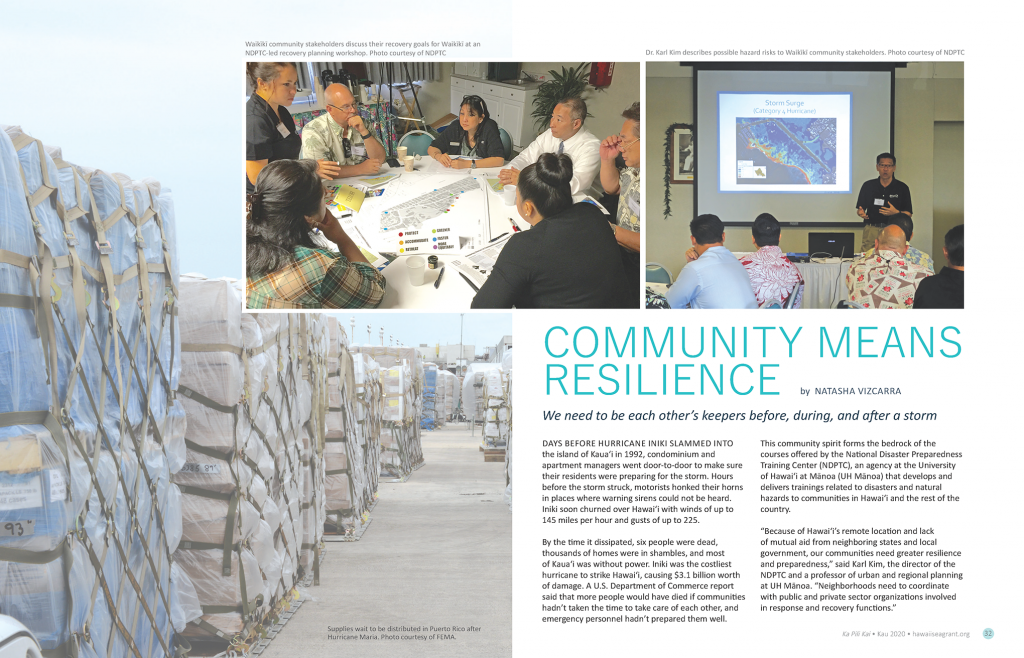Days before Hurricane Iniki slammed into the island of Kauaʻi in 1992, condominium and apartment managers went door-to-door to make sure their residents were preparing for the storm. Hours before the storm struck, motorists honked their horns in places where warning sirens could not be heard. Iniki soon churned over Hawaiʻi with winds of up to 145 miles per hour and gusts of up to 225.
By the time it dissipated, six people were dead, thousands of homes were in shambles, and most of Kauaʻi was without power. Iniki was the costliest hurricane to strike Hawaiʻi, causing $3.1 billion worth of damage. A U.S. Department of Commerce report said that more people would have died if communities hadn’t taken the time to take care of each other, and emergency personnel hadn’t prepared them well.
This community spirit forms the bedrock of the courses offered by the National Disaster Preparedness Training Center (NDPTC), an agency at the University of Hawaiʻi at Mānoa (UH Mānoa) that develops and delivers trainings related to disasters and natural hazards to communities in Hawaiʻi and the rest of the country.
“Because of Hawaiʻi’s remote location and lack of mutual aid from neighboring states and local government, our communities need greater resilience and preparedness,” said Karl Kim, the director of the NDPTC and a professor of urban and regional planning at UH Mānoa. “Neighborhoods need to coordinate with public and private sector organizations involved in response and recovery functions.”
You may not be buddies with the neighbor across the street, but you could be each other’s best chance of survival during a disaster. According to the Federal Emergency Management Agency (FEMA), 46 percent of individuals can expect to rely a great deal on people in their neighborhood for assistance within the first 72 hours after a disaster.
“These concepts, called social capital and social cohesion, are important in disaster management” said Roberto Porro, NDPTC’s coastal program manager. “Essentially, these mean the stronger the connections are within your community or your social network, the better prepared you are for a disaster.”
Kim’s leadership of the NDPTC mirrors the concept of social cohesion. “He has a unique ability to bring people together and build networks,” Porro said. “He’s always willing to work with others all over the world that are doing new and innovative things in the field of disaster preparedness.”
“We need to apply these broader lessons of resilience and preparedness to complex challenges like the coronavirus (COVID-19) pandemic which requires a global, multi-sector, interdisciplinary response,” Kim said. “We need to do a better job integrating science, technology, and community engagement.”
Here, Kim talks about crucial steps that communities in Hawaiʻi should take before the next Iniki crosses the islands again.
What are some actions that help to build neighborhood-level resilience?
We need training and education. We need to develop pilot programs that integrate mitigation and adaptation efforts to prepare neighborhoods for hurricanes, and participate in the Community Rating System, which will lower National Flood Insurance premiums. We also need to work with others to promote a culture of preparedness, and recognize the value of preparedness, mitigation, and pre-disaster planning.
How can neighbors prepare themselves to be first responders post-disaster?
There are training programs such as the Community Emergency Response Teams (CERT) offered by FEMA, as well as programs developed by the Red Cross and other NGOs, to support preparedness and response. The NDPTC focuses on the training of emergency managers and first responders, and preparation of the whole community in disaster preparedness, response, and recovery.
More attention needs to go towards the planning, design, engineering of safe communities through better land use planning, site selection and design, and construction of structures that can survive hurricanes and the associated hazards and threats. We need to design structures to not only withstand high winds, heavy rainfall, and flooding, but also to function with the loss of power, water, and wastewater services. These will also help increase the resilience to hurricanes.
How do people prepare in the days leading up to a hurricane?
With hurricanes, due to advances in forecasting and monitoring technologies, there are usually several days of warning so individuals, businesses, and governments can make plans to store water, food, and emergency supplies. People can also take protective actions to prepare their homes and businesses for the possibility of flooding, high winds, and other impacts such as the loss of power or the potential for fuel shortages.
As the hurricane approaches, emergency operations centers, and procedures for utilities and transportation agencies, hospitals, and other services will also kick in. There is a special need to focus on vulnerable populations, those in care homes and in need of support during disasters.
What role can neighbors and immediate community fill in the days following a natural disaster?
Neighbors and community members need to identify vulnerable, at-risk households and individuals, and be prepared to assist and help others ensure for their safety and well-being. In addition to identifying vulnerable community members, it is helpful to establish communications before, during, and after events occur to ensure that assistance gets to those most in need.
In addition to knowing your neighbors, community members need to take responsibility for those who may need assistance during hurricanes and other hazardous events. They need to share information with first responders, emergency medical services, and those providing relief and assistance following a disaster. They may need to assist with evacuation and transporting vulnerable populations to shelters or to safe zones away from flooding or other hazards. In addition to household plans, neighborhoods and communities need to develop local plans for evacuation and sheltering, and also recovery from hurricanes.
Browse Ka Pili Kai issues HERE


